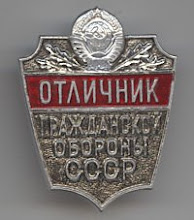
Since I arrived in Russia three months ago I have been accumulating books not merely about civil defense, but also about the Soviet civilian nuclear power. The one on the left is titled "NPP with VVER: Procedures, Characteristics, Effectiveness," and the one on the right is "Channelized Water-Graphite Reactors: Textbook."
The book on water-graphite reactors is particularly interesting, as it was sent to press a mere six months before the accident at Chernobyl Unit 4. In the fourth chapter, "Safety of Nuclear Reactors," the authors note that:
Нарушение соответствия между выделяемым и отводимым теплом и, как следствие этого, разрушение твэлов и других элементов конструкции могут возникуть или при повышении энерговыделения выше допустимого уровня, или при ухудшении теплоотвода. В результате бесконтрольного увеличения реактивности первый процесс возможен как в активной зоне в целом, так в отдельных ее частях. Причинами такого явления могут быть, например, заклинивание регулируюших стержей на вводе в активную зону, резкие изменения темпуратуры теплоносителя и т. п.
A lack of agreement between produced and removed heat, and consequently the destruction of fuel elements and other elements of construction, can result from either an increase in heat production beyond acceptable levels, or from a reduction in heat removal. The first process is possible as a result of an uncontrolled increase in reactivity in the active zone as a whole, or in a part of it. The causes of such an event can be, for instance, the jamming of control rods on entry to the active zone, abrupt changes in coolant temperature, and so forth. (p. 104)
Although such a reactivity spike caused the explosion at Chernobyl, it's clear from the textbook that the accident the authors envisioned was much more limited than that which actually transpired. This was probably because if the RBMK-1000 was operated according to regulations, the resulting power excursion would have been much smaller. (RBMKs have "safety rods" as well as control rods, and the operators removed most of these in order to start the reactor while it was subject to xenon poisoning, leaving it in an extremely unstable and dangerous state.) In any case, the book is merely an introduction (albeit a highly technical one) to Soviet water-graphite reactors. I'll keep my eye out for a more complete account of RBMKs, like the book about VVERs on the left.

5 comments:
Interesting finds. Did you see anything radically different between their VVER designs and Western LWR ones?
Well, the main LASTING difference was the VVER's distinctive steam generators. But the early VVERs are interesting in that they were designed with the same design philosophy (safety-wise) as the RBMK--confinements instead of proper containments, as well as relatively weak engineered safety. Honestly, I think that the Soviets themselves were much more worried about these reactors than the RBMKs prior to Chernobyl, seeing as the subsequent VVERs received radically updated safety improvements. After TMI, it was easy to imagine how a LOCA could result in a genuine catastrophe at one of the early VVERs, since besides lacking a confinement they also lacked robust systems for emergency cooling. Subsequent VVERs received containments and better engineered safety; today they are pretty much conventional except for the horizontal steam generators.
I get the impression that the Soviets considered Western safety concerns to be misplaced. The early early Soviet submarine reactors seem to have very bad safety features. It was, for example to pull the control rods out of a submarine reactor by simply opening a hatch above the reactor. Of course that happened.
Although the RBMK does not even come close to meeting western standards for reactor safety, the problem wasn't so much that it's unsafe as that it's not idiot-proof.
If someone had asked the designers in the late 1970's if the reactor could be dangerous if it were brought up to high power then suddenly shut down with the auxiliary feed water system intentionally disabled and then it had the control rods withdrawn while it was in an unstable state of xenon poisoning and still with no adequate cooling, I would think their answer would be "Oh sure, it could be very dangerous if that happened, but why the hell would anyone ever do something like that?"
Well I don't know what was soviet's opinion about RMBKs and VVERs, except that RBMKS were cheaper (and also good weapons-grade plutonium producers).
It's true that the first VVERs lacked appropiate containment building. Also, the VVER-440 V-230 lacked emergency cooling (I don't know how important it is having 6 independent loops). But, as I know, VVERs were being improved from the beginning, approaching Western standards. The first VVER-1000, "similar" in security to Western standards, was on-line in 1980, well before Chernobyl accident.
It's true that after Chernobyl Russians had to do massive reforms in their reactors and redesign their models. In fact I think the VVER-1200 is one of the safest reactors in the world (it has an impressive 3'4 meters thick containment building).
Thanks for your blog, it's difficult to find independent and objective information about the USSR.
Post a Comment